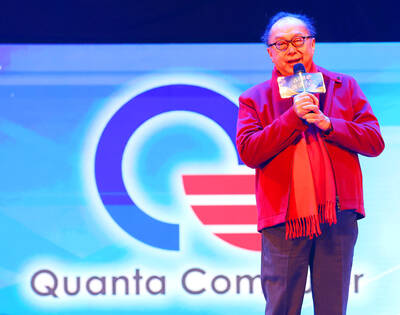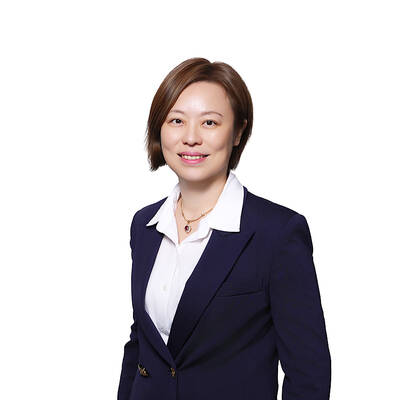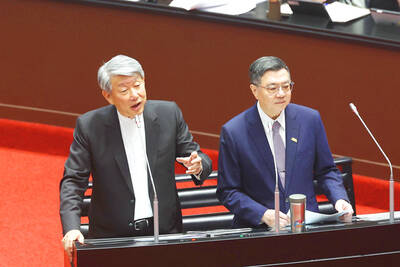The Far Eastern Group (遠東集團) reported revenues of NT$250 billion last year and expects the figure to reach NT$300 billion this year, underpinned by the strengthening domestic economy and the developing Chinese market, group chairman Douglas Hsu (徐旭東) told shareholders yesterday.
"I believe we'll create more shareholder value this year as fundamentals of our businesses are sound," Hsu said.
Far Eastern held a two-day investor conference from Monday for its eight public companies, which include Far Eastern Textile Ltd (遠東紡織), Asia Cement Corp (亞洲水泥), Far EasTone Telecommunications Co (遠傳電信) and U-Ming Marine Transport Corp (裕民航運).
One of the group's high-profile companies is U-Ming, the nation's largest bulk carrier shipping company, which reported record-breaking sales of NT$7.53 billion with after-tax profits amounting to NT$2.3 billion and earnings per share (EPS) of NT$3.7 last year.
Market watchers were speculating that U-Ming's EPS may hit NT$10 this year. U-Ming President C. K. Ong (
Besides taking advantage of the global demand for freight transportation, U-Ming plans to expand its business across the Taiwan Strait in view of China now importing 30 percent of the world's ore, Ong said, adding that the company is considering incorporating inland transportation in the massive Chinese market.
Group companies that also aim at the Chinese market include Far Eastern Textile with sales of NT$34.1 billion last year, and Far Eastern Department Stores Ltd (
Far Eastern Department Stores plans to open at least three outlets in each first-tier city in China, like Shanghai and Beijing, and expects to reach sales of 300 million yuan in each store each year and break even within three years, said Alice Hsu (徐荷芳), president of the department-store chain.
The group also seeks to increase investment in local market by opening more outlets, starting with its flagship store in Hsinyi District's A13 construction site and a Banchiao outlet set to launch in 2006, Hsu said. It also seeks to open a new Sogo Department Store near its Chunghsiao East Road store, but Hsu said the project is still under negotiation.
On top of the new stores, Far Eastern Department Stores will form a joint venture with Hong Kong supermarket chain City'Super Ltd to open a multi-function supermarket within its department stores. The first one is set to launch in December in its Far Eastern Shopping Mall, Hsu said.
The group's other money-spinning venture is Far EasTone Telecommunications Co (遠傳電信), the nation's second-largest mobile-phone carrier after acquiring smaller rival KG Telecommunications Co (和信電訊) in October last year. Far EasTone saw combined after-tax revenue of NT$8.19 billion last year and EPS of NT$3.7.
Far EasTone President Jan Nilsson said the focus of the company is to promote its third-generation (3G) mobile network with a capital expenditure of NT$10 billion this year. Far EasTone's merger with KG Telecom helped the company forge a closer partnership with Japanese telecommunication giant NTT DoCoMo, which was a minority stakeholder in KG Telecom and now owns a 4.9 percent stake in the combined company.
Far EasTone has about 8.2 million subscribers, not far behind state-run Chunghwa Telecom Co (

Quanta Computer Inc (廣達) chairman Barry Lam (林百里) is expected to share his views about the artificial intelligence (AI) industry’s prospects during his speech at the company’s 37th anniversary ceremony, as AI servers have become a new growth engine for the equipment manufacturing service provider. Lam’s speech is much anticipated, as Quanta has risen as one of the world’s major AI server suppliers. The company reported a 30 percent year-on-year growth in consolidated revenue to NT$1.41 trillion (US$43.35 billion) last year, thanks to fast-growing demand for servers, especially those with AI capabilities. The company told investors in November last year that

Intel Corp has named Tasha Chuang (莊蓓瑜) to lead Intel Taiwan in a bid to reinforce relations between the company and its Taiwanese partners. The appointment of Chuang as general manager for Intel Taiwan takes effect on Thursday, the firm said in a statement yesterday. Chuang is to lead her team in Taiwan to pursue product development and sales growth in an effort to reinforce the company’s ties with its partners and clients, Intel said. Chuang was previously in charge of managing Intel’s ties with leading Taiwanese PC brand Asustek Computer Inc (華碩), which included helping Asustek strengthen its global businesses, the company

Taiwanese suppliers to Taiwan Semiconductor Manufacturing Co. (TSMC, 台積電) are expected to follow the contract chipmaker’s step to invest in the US, but their relocation may be seven to eight years away, Minister of Economic Affairs J.W. Kuo (郭智輝) said yesterday. When asked by opposition Chinese Nationalist Party (KMT) Legislator Niu Hsu-ting (牛煦庭) in the legislature about growing concerns that TSMC’s huge investments in the US will prompt its suppliers to follow suit, Kuo said based on the chipmaker’s current limited production volume, it is unlikely to lead its supply chain to go there for now. “Unless TSMC completes its planned six

TikTok abounds with viral videos accusing prestigious brands of secretly manufacturing luxury goods in China so they can be sold at cut prices. However, while these “revelations” are spurious, behind them lurks a well-oiled machine for selling counterfeit goods that is making the most of the confusion surrounding trade tariffs. Chinese content creators who portray themselves as workers or subcontractors in the luxury goods business claim that Beijing has lifted confidentiality clauses on local subcontractors as a way to respond to the huge hike in customs duties imposed on China by US President Donald Trump. They say this Chinese decision, of which Agence